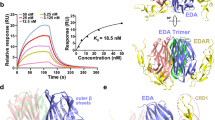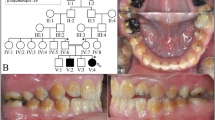Abstract
Mutations of the Ectodysplasin-A (EDA) gene are generally associated with the syndrome hypohidrotic ectodermal dysplasia (MIM 305100), but they can also manifest as selective, non-syndromic tooth agenesis (MIM300606). We have performed an in vitro functional analysis of six selective tooth agenesis-causing EDA mutations (one novel and five known) that are located in the C-terminal tumor necrosis factor homology domain of the protein. Our study reveals that expression, receptor binding or signaling capability of the mutant EDA1 proteins is only impaired in contrast to syndrome-causing mutations, which we have previously shown to abolish EDA1 expression, receptor binding or signaling. Our results support a model in which the development of the human dentition, especially of anterior teeth, requires the highest level of EDA-receptor signaling, whereas other ectodermal appendages, including posterior teeth, have less stringent requirements and form normally in response to EDA mutations with reduced activity.
Similar content being viewed by others
Log in or create a free account to read this content
Gain free access to this article, as well as selected content from this journal and more on nature.com
or
References
Thesleff I : Epithelial-mesenchymal signaling regulating tooth morphogenesis. J Cell Sci 2003; 116: 1647–1648.
Vastardis H, Karimbux N, Guthua SW, Seidman JG, Seidman C : A human MSX1 homeodomain missense mutation causes selective tooth agenesis. Nat Genet 1996; 13: 417–421.
Stockton DW, Das P, Goldenberg M, D’Souza RN, Patel PI : Mutation of PAX9 is associated with oligodontia. Nat Genet 2000; 24: 18–19.
Lammi L, Arte S, Somer M et al: Mutations in AXIN2 cause familial tooth agenesis and predispose to colorectal cancer. Am J Hum Genet 2004; 74: 1043–1050.
Van den Boogaar M-JH, Dorland M, Beemer FA, Ploos van Amstel HK : MSX1 mutation is associated with orofacial clefting and tooth agenesis in humans. Nat Genet 2000; 24: 342–343. Erratum: Nat Genet 2000; 25: 125.
Tao R, Jin B, Guo SZ et al: A novel missense mutation of the EDA gene in a Mongolian family with congenital hypodontia. J Hum Genet 2006; 51: 498–502.
Tarpey P, Pemberton TJ, Stockton DW et al: A novel Gln358Glu mutation in ectodysplasin-A associated with X-linked dominant incisor hypodontia. Am J Med Genet 2007; 143A: 390–394.
Schneider P, Street SL, Gaide O et al: Mutations leading to X-linked hypohidrotic ectodermal dysplasia affect three major functional domains in the tumor necrosis factor family member ectodysplasin-A. J Biol Chem 2001; 276: 18819–18827.
Li S, Li J, Cheng J et al: Non-syndromic tooth agenesis in two Chinese families associated with novel missense mutation in the TNF domain of EDA (ectodysplasin A). PLoS ONE 2008; 3: e2396.
Han D, Gong Y, Wu H et al: Novel EDA mutation resulting in X-linked non-syndromic hypodontia and the pattern of EDA-associated isolated tooth agenesis. Eur J Med Genet 2008; 51: 536–546.
Rasool M, Schuster J, Aslam M et al: A novel missense mutation in the EDA gene associated with X-linked recessive isolated hypodontia. J Hum Genet 2008; 53: 894–898.
Fan H, Ye X, Shi L et al: Mutations in the EDA gene are responsible for X-linked hypohidrotic ectodermal dysplasia and hypodontia in Chinese kindreds. Eur J Oral Sci 2008; 116: 412–417.
Kere J, Srivastava AK, Montonen O et al: X-linked anhidrotic (hypohidrotic) ectodermal dysplasia is caused by mutation in a novel transmembrane protein. Nat Genet 1996; 13: 409–416.
Zonana J, Clarke A, Sarfarazi M et al: X-linked hypohidrotic ectodermal dysplasia: localization within the region Xq11-21.1 by linkage analysis and implications for carrier detection and prenatal diagnosis. Am J Hum Genet 1988; 43: 75–85.
Bayés M, Hartung AJ, Ezer S et al: The anhidrotic ectodermal dysplasia gene (EDA) undergoes alternative splicing and encodes ectodysplasin-A with deletion mutations in collagenous repeats. Hum Mol Genet 1998; 7: 1661–1669.
Monreal A, Zonana J, Ferguson B : Identification of a new splice form of the EDA1 gene permits detection of nearly all x-linked hypohidrotic ectodermal dysplasia mutations. Am J Hum Genet 1998; 63: 380–389.
Ezer S, Bayés M, Elomaa O, Schlessinger D, Kere J : Ectodysplasin is a collagenous trimeric type II membrane protein with a tumor necrosis factor-like domain and co-localizes with cytoskeletal structures at lateral and apical surfaces of cells. Hum Mol Genet 1999; 8: 2079–2086.
Elomaa O, Pulkkinen K, Hannelius U, Mikkola M, Saarialho-Kere U, Kere J : Ectodysplasin is released by proteolytic shedding and binds to the EDAR protein. Hum Mol Genet 2001; 10: 953–962.
Yan M, Wang LC, Hymowitz SG et al: Two-amino acid molecular switch in an epithelial morphogen that regulates binding to two distinct receptors. Science 2000; 290: 523–527.
Monreal A, Ferguson BM, Headon DJ, Street SL, Overbeek PA, Zonana J : Mutations in the human homologue of mouse dl cause autosomal recessive and dominant hypohidrotic ectodermal dysplasia. Nat Genet 1999; 22: 366–369.
Newton K, French DM, Yan M, Frantz GD, Dixit VM : Myodegeneration in EDA-A2 transgeneic mice is prevented by XEDAR deficiency. Mol Cell Biol 2004; 24: 1608–1613.
Chen Y, Molloy SS, Thomas L et al: Mutations within a furin consensus sequence block proteolytic release of ectodysplasin-A and cause X-linked hypohidrotic ectodermal dysplasia. PNAS 2001; 98: 7218–7223.
Thompson JS, Bixler SA, Qian F et al: BAFF-R, a newly identified TNF receptor that specifically interacts with BAFF. Science 2001; 293: 2108–2111.
Bossen C, Cachero TG, Tardivel A et al: Interactions of tumor necrosis factor (TNF) and TNF receptor family members in the mouse and human. Blood 2008; 111: 1004–1012.
Gaide O, Schneider P : Permanent correction of an inherited ectodermal dysplasia with recombinant EDA. Nat Med 2003; 9: 614–618.
Schneider P, Holler N, Bodmer JL et al: Conversion of membrane-bound FAS (CD95) ligand to its soluble form is associated with downregulation of its proapoptotic activity and loss of liver toxicity. J Exp Med 1998; 187: 1205–1213.
Holler N, Tardivel A, Kovacsovics-Bankowski M et al: Two adjacent trimeric FAS ligands are required for FAS signaling and formation of a death-inducing signaling complex. Mol Cell Biol 2003; 23: 1428–1440.
Jumlongras D, Bei M, Stimson JM et al: A nonsense mutation in MSX1 causes Witkop syndrome. Am J Hum Genet 2001; 69: 67–74.
Lexner MO, Bardow A, Hertz JM, Nielsen LA, Kreiborg S : Anomalies of tooth formation in hypohidrotic ectodermal dysplasia. Internat J Paed Dent 2006; 17: 10–18.
Song S, Han D, Qu H et al: EDA gene mutations underlie non-syndromic oligodontia. J Dent Res 2009; 88: 126–131.
Mues G, Griggs R, Hartung AJ et al: From ectodermal dysplasia to selective tooth agenesis. Am J Med Genet 2009, e-pub ahead of print 5 June 2009; doi: 10.1002/ajmg.a.32801.
Colosimo PF, Hosemann KE, Balabhadra S et al: Widespread parallel evolution in sticklebacks by repeated fixation of ectodysplasin alleles. Science 2005; 307: 1928–1933.
Zonana J, Elder ME, Schneider LC et al: A novel X-linked disorder of immune deficiency and hypohidrotic ectodermal dysplasia is allelic to Incontinentia Pigmenti and due to mutations in IKK-gamma (NEMO). Am J Hum Genet 2000; 67: 1555–1562.
Casal ML, Lewis JR, Mauldin EA et al: Significant correction of disease after postnatal administration of recombinant ectodysplasin A in canine X-linked ectodermal dysplasia. Am J Hum Genet 2007; 81: 1050–1060.
Acknowledgements
We thank the tooth agenesis family for their cooperation, Joseph F Maher, MD, for advice with the EDA questionnaire, and Sarah C Pollan White, DDS, for orthodontic evaluations. This work was supported by National Institute of Health Grant U24-PEI6472 to RDS and by Swiss National Science Foundation Grant 3100A0–122553 to PS.
Author information
Authors and Affiliations
Corresponding author
Rights and permissions
About this article
Cite this article
Mues, G., Tardivel, A., Willen, L. et al. Functional analysis of Ectodysplasin-A mutations causing selective tooth agenesis. Eur J Hum Genet 18, 19–25 (2010). https://doi.org/10.1038/ejhg.2009.127
Received:
Revised:
Accepted:
Published:
Issue date:
DOI: https://doi.org/10.1038/ejhg.2009.127
Keywords
This article is cited by
-
Rethinking the Genetic Etiology of Nonsyndromic Tooth Agenesis
Current Osteoporosis Reports (2022)
-
Comprehensive genetic exploration of selective tooth agenesis of mandibular incisors by exome sequencing
Human Genome Variation (2017)
-
Nonsyndromic oligodontia
Journal of Orofacial Orthopedics / Fortschritte der Kieferorthopädie (2017)
-
Novel missense mutation in the EDA gene in a family affected by oligodontia
Journal of Orofacial Orthopedics / Fortschritte der Kieferorthopädie (2016)
-
Pharmacological Stimulation of Edar Signaling in the Adult Enhances Sebaceous Gland Size and Function
Journal of Investigative Dermatology (2015)



